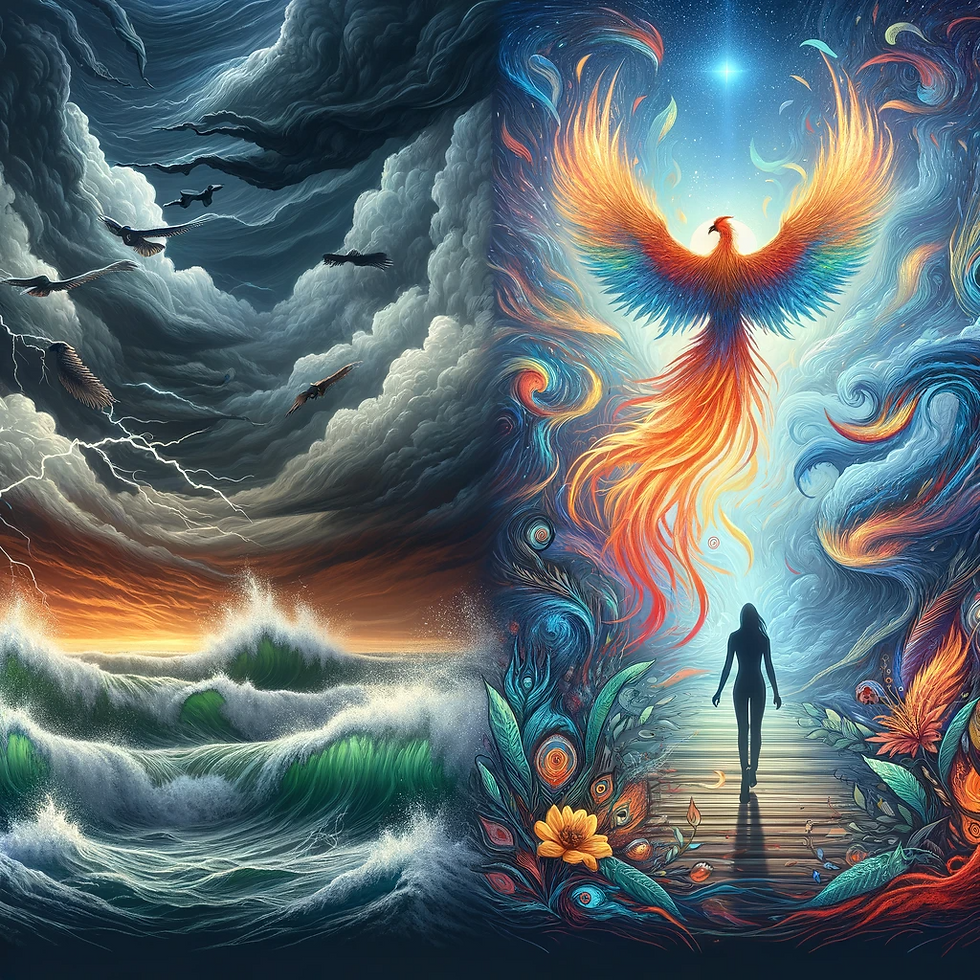We've all been there - those life moments that knock the wind out of our sails. Moments so intense they feel like gut-punches, changing the trajectory of our stories. But here’s the riddle: Can every rough patch be equated to the shadow of PTSD, or is it merely a chapter in the book of life’s traumas?

Encountering the Storms: The Impact of Trauma
Throughout our journey, certain experiences or sequences of events have the power to disrupt our inner equilibrium. They send shockwaves through our mental, emotional, and physical states. Think of these as the storms in our life – sudden, overwhelming, and transformative.
The Biology of Overwhelm: The Fight, Flight, and Freeze
Our reaction to trauma is not random; it's deeply rooted in evolution.
You might wonder, why such intense reactions? Well, our evolutionary mechanism of "fight, flight, and freeze" has a role to play. Historically, these responses kept us safe from predators and threats. We'd either defend ourselves (fight), run away (flight), or become immobilized, blending with our environment (freeze). Both trauma and PTSD trigger this freeze response. It's as if our system experiences an overload and instead of processing the event, it gets stuck in a loop.
In the context of trauma, this freeze can expand unpredictably, impacting areas of our lives that might not directly relate to the traumatic incident. PTSD, however, is more focused. It's like being caught in a repetitive storm, where the mind relentlessly revisits specific traumatic events.
Both trauma and PTSD represent that unexpected whirlwind, pulling the rug from under our feet, leaving us to grapple with fragments of our former selves. Whether it's the heartbreak of losing someone dear, the shock of an accident, or the weight of surviving a near-death scenario, these moments challenge our equilibrium, making us question our safety and sanity.

PTSD: The Ghosts That Won't Let Go
If traumatic events are the storms that break our windows, PTSD is the relentless gust that sneaks in through the cracks, reminding us of the storm long after it’s passed. It's more than just memories; it’s a mental bind that chains us to our traumas.
Experiencing a traumatic event might jolt our brain, blurring the lines between the past and the present. When PTSD sneaks in, it brings along intrusive memories, restless nights, and constant anxiety, making it hard to distinguish yesterday's storm from today's calm.

Recognizing Our Battles & Calling in Reinforcements
Awareness is the first step to healing. It's one thing to feel momentarily lost post a traumatic event and entirely another to continuously drown in a sea of dread. If the shadows of trauma refuse to fade and disrupt daily life, it might be PTSD raising its head.
If this sounds like you or someone you care about, remember, there's strength in seeking help. Professionals well-versed in the language of trauma are out there, ready to extend a hand and guide you through the storm.
It's important to note that while trauma refers to the experience of something distressing or disturbing, PTSD (Post-Traumatic Stress Disorder) is a specific mental health condition that can develop in some people after they've experienced a traumatic event. Here are some signs to help identify whether someone might have experienced trauma or has developed PTSD.

Signs of Trauma:
Experiencing trauma can lead to a variety of immediate and short-term emotional, physical, and cognitive responses, including:
Shock or denial: Feeling numb or finding it hard to accept what happened.
Mood swings: Rapid and intense mood changes.
Sleep disturbances: Difficulty sleeping or nightmares.
Physical symptoms: Fatigue, being startled easily, difficulty concentrating, or even a racing heartbeat.
Avoidance: Avoiding places, people, or activities that are reminders of the traumatic event.
Anxiety or fear: Persistent feeling of being in danger.
Signs of PTSD:
PTSD symptoms are more chronic and can arise weeks, months, or even years after the traumatic event. They can be grouped into four main categories:
Intrusive thoughts:
Re-experiencing: Reliving the traumatic event through flashbacks or nightmares.
Upsetting dreams about the traumatic event.
Physical reactions to reminders of the event, like sweating or nausea.
Avoidance:
Avoiding places, activities, or people that remind them of the traumatic event.
Avoiding thoughts or feelings related to the traumatic event.
Negative changes in thoughts and mood:
Negative feelings about oneself or others.
Feeling numb or detached from others.
Lack of interest in once-enjoyable activities.
Persistent negative mood, like sadness or fear.
Difficulty recalling details of the traumatic event.
Arousal and reactive symptoms:
Being easily startled or frightened.
Self-destructive behavior, such as drinking too much or driving too fast.
Difficulty concentrating or sleeping.
Irritability or angry outbursts or aggressive behavior.
Overwhelming guilt or shame.
If someone exhibits these signs, especially if they persist for more than a month and interfere with daily functioning, it's essential to consult a mental health professional. They can provide a proper diagnosis and guide the person to appropriate treatments or interventions.
Mending the Broken: The Path to Renewal
It's important to understand that our world is far from ideal, and expecting a life without challenges is unrealistic. Many people mistakenly seek to sidestep pain and crave certainty in inherently uncertain situations. These efforts can amplify distress, potentially intensifying the impact of trauma and PTSD. Remember, you can't avoid pain, but you can rise above suffering.
Recovering from the aftermath of trauma and PTSD is not a sprint; it's a marathon. Treat it with kindness. Here’s how:
Self-Love: Find your sanctuary, whether it's in the rhythm of a workout, the peace of meditation, or the embrace of nature. This journey begins with self.
Unity in Experience: Sharing stories with friends, family, or even specialized groups can create a tapestry of support, reminding you that you're not alone.
Guided Healing: Therapists specializing in trauma-focused methods can be the compass pointing towards your true north.

Embracing Calm After the Storm
Understanding the nuances between life’s traumatic events and PTSD empowers us to navigate our mental labyrinth. Life might throw its challenges, cracking the windows of our soul. Yet, with awareness, support, and dedication, we can piece together our stained glass, allowing our spirit to bask in the light again.
In the end, healing is a commitment—a promise to oneself. Embrace it, and remember: in this journey, you're never alone. The world is full of hands waiting to help you rise.
Never give up on yourself. You can grow from trauma and recover from PTSD.
Though trauma and PTSD can define moments in our life, they are neither your destiny nor your destination.

Comments